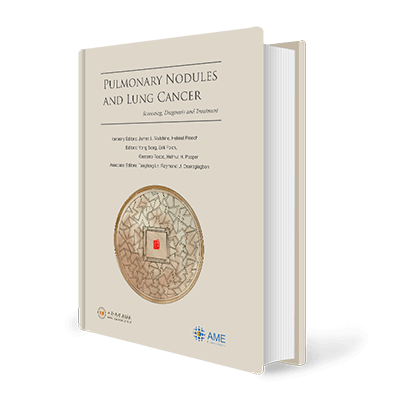Ground-glass Opacity and Lung Cancer
68 What do we know about ground-glass opacity nodules in the lung?
Choon-Taek Lee
72 Pulmonary ground-glass opacity: computed tomography features, histopathology and molecular pathology
Jian-Wei Gao, Stefania Rizzo, Li-Hong Ma, Xiang-Yu Qiu, Arne Warth, Nobuhiko Seki, Mizue Hasegawa, Jia-Wei Zou, Qian Li, Marco Femia, Tang-Feng Lv, Yong Song; written on behalf of the AME Lung Cancer Collaborative Group
80 Management of ground-glass opacities: should all pulmonary lesions with ground-glass opacity be surgically resected?
Yoshihisa Kobayashi, Tetsuya Mitsudomi
90 Computed tomography guided microcoil localization for pulmonary small nodules and ground-glass opacity prior to thoracoscopic resection
Xizhao Sui, Hui Zhao, Feng Yang, Ji-Lun Li, Jun Wang
Pulmonary Nodules and Lung Cancer
98 The imaging of small pulmonary nodules
Zejun Zhou, Ping Zhan, Jiajia Jin, Yafang Liu, Qian Li, Chenhui Ma, Yingying Miao, Qingqing Zhu, Panwen Tian, Tangfeng Lv, Yong Song
104 Risk assessment in relation to the detection of small pulmonary nodules
John K. Field, Michael W. Marcus, Matthijs Oudkerk
111 Evaluation of pulmonary nodules in Asian population
Chee K. Phua, Wen Y. Sim, Kuan Sen Tee, Sennen J. W. Lew, Albert Y. H. Lim, Dessmon Y. H. Tai, Soon Keng Goh, Ai Ching Kor, Alan W. K. Ng, John Abisheganaden, Akash Verma
119 Comments on characterization of solitary pulmonary nodules with 18F-FDG PET/CT relative activity distribution analysis
Orazio Schillaci, Ferdinando F. Calabria
124 18F- uorodeoxyglucose positron emission tomography/computed tomography characterization of solitary pulmonary nodules: can we do better?
Ana María García Vicente, Víctor M. Pérez-García, Ángel Soriano Castrejón
128 Radiomics of pulmonary nodules and lung cancer
Ryan Wilson, Anand Devaraj
134 From diagnosis to therapy in lung cancer: management of CT detected pulmonary nodules, a summary of the 2015 Chinese-German Lung Cancer Expert Panel
Chunxia Su, Mathias Meyer, Robert Pirker, Wieland Voigt, Jingyun Shi, Lothar Pilz, Rudolf M. Huber, Yilong Wu, Jinghong Wang, Yonglan He, Xuan Wang, Jian Zhang, Xiuyi Zhi, Meiqi Shi, Bo Zhu, Stefan S. Schoenberg, Thomas Henzler, Christian Manegold, Caicun Zhou, Eric Dominic Roessner
Pulmonary Nodules Diagnosis
146 How to diagnose pulmonary nodules: from screening to therapy
Yanwen Yao, Tangfeng Lv, Yong Song
149 Transthoracic needle aspiration in solitary pulmonary nodule
Wen Yang, Hongli Jiang, Ali Nawaz Khan, Carolyn Allen, Luca Bertolaccini, Tangfeng Lv, Yong Song; written on behalf of the AME Lung Cancer Collaborative Group
159 18F-FDG-PET/CT in the assessment of pulmonary solitary nodules: comparison of different analysis methods and risk variables in the prediction of malignancy
Ober van Gómez López, Ana María García Vicente, Antonio Francisco Honguero Martínez, Germán Andrés Jiménez Londoño, Carlos Hugo Vega Caicedo, Pablo León Atance, Ángel María Soriano Castrejón
167 Comparison between endobronchial ultrasound-guided transbronchial biopsy and CT-guided transthoracic lung biopsy for the diagnosis of peripheral lung cancer: a systematic review and meta-analysis
Ping Zhan, Qing-Qing Zhu, Ying-Ying Miu, Ya-Fang Liu, Xiao-Xia Wang, Ze-Jun Zhou, Jia-Jia Jin, Qian Li, Shinji Sasada, Takehiro Izumo, Chih-Yen Tu, Wen-Chien Cheng, Matthew Evison, Tang-Feng Lv, Yong Song; written on behalf of the AME Lung Cancer Collaborative Group
179 Correlation in histological subtypes with high resolution computed tomography signatures of early stage lung adenocarcinoma
Yingying Miao, Jianya Zhang, Jiawei Zou, Qingqing Zhu, Tangfeng Lv, Yong Song
188 Lung cancer diagnosis and staging in the minimally invasive age with increasing demands for tissue analysis
Erik Folch, Daniel B. Costa, Jeffrey Wright, Paul A. VanderLaan
200 Early diagnosis of solitary pulmonary nodules
Chunhua Xu, Keke Hao, Yong Song, Like Yu, Zhibo Hou, Ping Zhan
213 Noninvasive computed tomography-guided marking technique for peripheral pulmonary nodules
Mingyon Mun, Yosuke Matsuura, Masayuki Nakao, Junji Ichinose, Ken Nakagawa, Sakae Okumura
218 Towards optimal pathologic staging of resectable non-small cell lung cancer
Raymond U. Osarogiagbon, Gail E. Darling
226 Diagnostic and therapeutic value of computed tomography guided coil placement after digital subtraction angiography guided video-assisted thoracoscopic surgery resection for solitary pulmonary nodules
Yong Qiang, Lei Zhang, Nan Yang, Jian Xu, De-Min Li, Tangfeng Lv, Ping Zhan, Yong Song, Zhong-Dong Li, Hao Li
Treatment of Pulmonary Nodules
233 Clinical outcomes of CyberKnife stereotactic radiosurgery for elderly patients with presumed primary stage I lung cancer
Zhen Wang, Ao-Mei Li, Jie Gao, Jing Li, Bing Li, Percy Lee, Charles B. Simone II, Yong Song, Xi-Xu Zhu; written on behalf of the AME Lung Cancer Collaborative Group
241 Sublobar resection for early-stage lung cancer
Hiroyuki Sakurai, Hisao Asamura
250 Is surgery still the best management option for early stage NSCLC?
Aurel Ottlakan, Nicola Martucci, Gaetano Rocco
255 Cons: long-term CT-scan follow-up is not the standard of care in patients curatively treated for an early stage non-small cell lung cancer
Jan P. van Meerbeeck, Halil Sirimsi
260 Pros: After stereotactic ablative radiotherapy for a peripheral early-stage non-small cell lung cancer, radiological suspicion of a local recurrence can be suf cient indication to proceed to salvage therapy
Timothy K. Nguyen, David A. Palma
264 Image-guided techniques for localizing pulmonary nodules in thoracoscopic surgery
Mong-Wei Lin, Jin-Shing Chen
271 Management strategy of solitary pulmonary nodules
Ping Zhan, Haiyan Xie, Chunhua Xu, Keke Hao, Zhibo Hou, Yong Song
278 Preoperative CT-Guided percutaneous wire localization of ground glass pulmonary nodules with a modi ed Kopans wire
Maureen P. Kohi, David M. Naeger, Jasleen Kukreja, Nicholas Fidelman, Jeanne M. LaBerge, Roy L. Gordon, Robert K. Kerlan Jr
283 Post-therapeutic positron emission tomography/computed tomography for early detection of non-small cell lung cancer recurrence
Sonja Sudarski, Thomas Henzler, Stefan O. Schoenberg
292 Interventional pulmonology approaches in the diagnosis and treatment of early stage non small cell lung cancer
Ryu Peter Hambrook Tofts, Peter MJ Lee, Arthur Wai Sung
308 Molecular testing in lung cancer in the era of precision medicine
Helmut H. Popper, Ales Ryska, József Tímár, Wlodzimierz Olszewski



